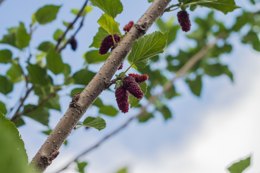Mulberry is a genus of deciduous trees that are commonly found in the temperate and subtropical regions of Asia, Europe, America, and Africa. They are mainly grown for their edible fruits. It is not very difficult to prune them, provided you select the appropriate timing and the technique for it.

Mulberry, also known as
Morus, is a genus of about 10 to 16 species of deciduous trees. Mulberry trees are native to the warm temperate, as well as the subtropical regions of Asia, Africa, America, and Europe. The trees are grown for their edible fruits and also for landscaping purposes. There are mainly three species of mulberries that are grown for their fruits. These are known as the white mulberry or
Morus alba, red mulberry or
Morus rubra, and black mulberry or
Morus nigra.
The fruits or berries of the mulberry tree are used for making pies, wine, and tarts. The leaves of the tree are lobed and are arranged alternately on the branches. The leaves, particularly those of the white mulberry are the main food of silkworm, and so, this tree is also cultivated for silk production. The mulberry tree can grow quite rapidly when it is young. The tree requires a little bit of care and attention to thrive properly, and pruning is an important part of plant care.
Trimming a Mulberry Tree
The Right Time
The ideal time for pruning is the dormant season, when the growth of the tree comes to a halt. It is not recommended to prune the tree, when it is still growing. During the dormant season, when there are no leaves on the tree, pruning can be done safely and easily. Generally, pruning is done in the late summer to promote new growth. In fall, pruning can be done before the frost, or when the tree is losing its foliage.
The fruitless mulberry tree, which is more commonly preferred for landscaping purposes, can be trimmed in early winter, when the tree loses all its foliage. However, you can make an exception to the timing of pruning, if you find a large number of diseased and damaged branches on the tree. Such branches can be removed at any time. Otherwise, the tree can become susceptible to diseases and pests. Similarly, trimming can also be done at other times of the year for safety issues, especially when the branches grow close to phone or power lines.
The Right Way
Pruning is more than just maintaining the shape and look of a tree. It is essential for maintaining the health of the plant by improving air circulation. While pruning, be sure to not remove more than one-third of the leaf canopy in a single year. It is also advisable to avoid heavy pruning. There are basically two methods employed for pruning this tree, including the fruitless and the weeping mulberry tree. These techniques are known as crown reduction and pollarding.
Pollarding is more commonly employed for the fruitless trees. In the crown reduction technique, the central leader is cut back to the length of the secondary branches. This method helps maintain the shape of the tree by reducing its crown size, or the height and spread of the crown. On the other hand, in pollarding, all branches are cut back to the main trunk to promote new growths. Each branch is pruned back to the knuckle, and the process is repeated every two years. Pollarding is basically carried out for young trees.
Both crown reduction and pollarding can cause a lot of damage to the tree over a period of time. The crown reduction can result in deep pruning wounds, that can prove harmful for the tree in the long-run. Therefore, if possible, try to avoid heavy pruning. Instead, keep the tree healthy by removing all dead, decayed, or diseased branches from time to time. You can also remove the branches that are crossing each other, or those that are touching the ground. While pruning a branch, either cut it back to the main trunk, or to the point from where another limb is growing from it. Consider to remove the suckers thriving at the base of the tree. Do not prune this tree more than twice in a year.
Pay attention to the other requirements of the plant, like light conditions and watering, in order to ensure its proper growth. The plant usually prefers full sun and moist, but well-drained soil. Watering is generally required only during the extremely dry period.






 Mulberry, also known as Morus, is a genus of about 10 to 16 species of deciduous trees. Mulberry trees are native to the warm temperate, as well as the subtropical regions of Asia, Africa, America, and Europe. The trees are grown for their edible fruits and also for landscaping purposes. There are mainly three species of mulberries that are grown for their fruits. These are known as the white mulberry or Morus alba, red mulberry or Morus rubra, and black mulberry or Morus nigra.
Mulberry, also known as Morus, is a genus of about 10 to 16 species of deciduous trees. Mulberry trees are native to the warm temperate, as well as the subtropical regions of Asia, Africa, America, and Europe. The trees are grown for their edible fruits and also for landscaping purposes. There are mainly three species of mulberries that are grown for their fruits. These are known as the white mulberry or Morus alba, red mulberry or Morus rubra, and black mulberry or Morus nigra.